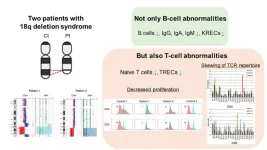(Press-News.org) An international research team has assembled the genome and 3D chromosomal structures of a 52,000-year-old woolly mammoth—the first time such a feat has been achieved for any ancient DNA sample. The fossilized chromosomes, which are around a million times longer than most ancient DNA fragments, provide insight into how the mammoth’s genome was organized within its living cells and which genes were active within the skin tissue from which the DNA was extracted. This unprecedented level of structural detail was retained because the mammoth underwent freeze-drying shortly after it died, which meant that its DNA was preserved in a glass-like state. The results are presented July 11 in the journal Cell.
“This is a new type of fossil, and its scale dwarfs that of individual ancient DNA fragments—a million times more sequence,” says corresponding author Erez Lieberman Aiden (@erezaterez), Director of the Center for Genome Architecture at Baylor College of Medicine. “It is also the first time a karyotype of any sort has been determined for an ancient sample.”
Knowing the three-dimensional architecture of a genome provides a lot of additional information beyond its sequence, but most ancient DNA specimens consist of very small, scrambled DNA fragments. Building off work mapping the 3D structure of the human genome, Aiden thought that if the right ancient DNA sample could be found—one with the 3D organization of the fragments still intact—it would be possible to use the same strategies to assemble ancient genomes.
The researchers tested dozens of samples over the course of five years before landing on an unusually well-preserved woolly mammoth that was excavated in northeastern Siberia in 2018. “We think it spontaneously freeze-dried shortly after its death,” says corresponding author Olga Dudchenko (@odudcha) of the Center for Genome Architecture at Baylor College of Medicine. “The nuclear architecture in a dehydrated sample can survive for an incredibly long period of time.”
To reconstruct the mammoth’s genomic architecture, the researchers extracted DNA from a skin sample taken behind the mammoth’s ear. They used a method called Hi-C that allows them to detect which sections of DNA are likely to be in close spatial proximity and interact with each other in their natural state in the nucleus.
“Imagine you have a puzzle that has three billion pieces, but you don't have the picture of the final puzzle to work from,” says corresponding author Marc A. Marti-Renom (@mamartirenom), an ICREA research professor and structural genomicist at the Centre Nacional d’Anàlisi Genòmica (CNAG) and the Centre for Genomic Regulation (CRG) in Barcelona. “Hi-C allows you to have an approximation of that picture before you start putting the puzzle pieces together.”
Then, they combined the physical information from the Hi-C analysis with DNA sequencing to identify the interacting DNA sections and create an ordered map of the mammoth’s genome, using the genomes of present-day elephants as a template. The analysis revealed that woolly mammoths had 28 chromosomes—the same number as present-day Asian and African elephants. Remarkably, the fossilized mammoth chromosomes also retained a huge amount of physical integrity and detail, including the nanoscale loops that bring transcription factors in contact with the genes they control.
By examining the compartmentalization of genes within the nucleus, the researchers were able to identify genes that were active and inactive within the mammoth’s skin cells—a proxy for epigenetics or transcriptomics. The mammoth skin cells had distinct gene activation patterns compared to the skin cells of its closest relative, the Asian elephant, including for genes potentially related to its woolly-ness and cold tolerance.
“For the first time, we have a woolly mammoth tissue for which we know roughly which genes were switched on and which genes were off,” says Marti-Renom. “This is an extraordinary new type of data, and it’s the first measure of cell-specific gene activity of the genes in any ancient DNA sample.”
Although the method used in this study hinges on unusually well-preserved fossils, the researchers are optimistic that it could be used to study other ancient DNA specimens—from mammoths to Egyptian mummies—as well as more recently preserved museum specimens.
For mammoths, the next steps would include examining the epigenetic patterns of other tissues. “These results have obvious consequences for contemporary efforts aimed at woolly mammoth de-extinction,” says corresponding author M. Thomas Gilbert, a paleo-genomicist at the University of Copenhagen and the Norwegian University of Science and Technology.
###
This research was supported by the National Institutes of Health, the National Science Foundation, the Welch Foundation, McNair Medical Institute, US-Israel Binational Science Foundation, Spanish Ministerio de Ciencia e Innovación, the European Research Council, Swedish Research Council, and the European Union.
Cell, Sandoval-Velasco, Dudchenko, Rodríguez, and Pérez Estrada, et al. “Three-dimensional genome architecture persists in a 52,000-year-old woolly mammoth skin sample” https://cell.com/cell/fulltext/S0092-8674(24)00642-1
Cell (@CellCellPress), the flagship journal of Cell Press, is a bimonthly journal that publishes findings of unusual significance in any area of experimental biology, including but not limited to cell biology, molecular biology, neuroscience, immunology, virology and microbiology, cancer, human genetics, systems biology, signaling, and disease mechanisms and therapeutics. Visit http://www.cell.com/cell. To receive Cell Press media alerts, contact press@cell.com.
END
An increased amount of thick sea ice flowing south from the Arctic Ocean shortened the ice-free shipping season in several parts of the Northwest Passage between 2007 and 2021, according to an analysis in Communications Earth & Environment. The authors suggest this could mean the Northwest Passage is unlikely to become a viable alternative to traditional shipping routes, despite previous hopes that it may become viable due to global warming.
The Northwest Passage (NWP) is a commercial shipping route connecting the Atlantic and Pacific Oceans that runs through the Arctic Circle north of North America. Through the Canadian ...
DURHAM, N.C. – Certain state gun laws are associated with decreased suicide rates for children under age 18, but the laws have little influence on homicide rates, according to a study from Duke Health researchers examining the relationship between gun laws and child deaths.
Since 2020, firearms rank as the leading cause of death among U.S. children ages 1-18, raising the need for research to help guide prevention efforts.
“Our analysis of suicide and homicide mortality data from ...
About The Study: Substance use treatment facilities reported significant gaps in provision of effective treatments for opioid use disorder (OUD). More than one-third of facilities did not offer medications for OUD (MOUD) and less than half offered multiple MOUD types, limiting MOUD treatment options for patients and clinicians.
Corresponding Author: To contact the corresponding author, Tae Woo Park, M.D., M.Sc., email parkt4@upmc.edu.
To access the embargoed study: Visit our For The Media website at this link https://media.jamanetwork.com/
(doi:10.1001/jama.2024.11913)
Editor’s ...
About The Study: In this cross-sectional study of U.S. children, nicotine absorption was much lower in children who were exposed to secondhand vapor versus secondhand smoke, but higher than in those exposed to neither. These findings suggest that switching from smoking to vaping indoors may substantially reduce, but not eliminate, children’s secondhand exposure to nicotine and other noxious substances.
Corresponding Author: To contact the corresponding author, Harry Tattan-Birch, Ph.D., email h.tattan-birch@ucl.ac.uk.
To ...
About The Study: This comparative effectiveness research study demonstrated that self-fit over-the-counter hearing aids can offer comparable long-term benefits to audiologist-fit hearing aids for individuals with mild to moderate hearing loss.
Corresponding Author: To contact the corresponding author, Karina C. De Sousa, Ph.D., email karina.swanepoel@up.ac.za.
To access the embargoed study: Visit our For The Media website at this link https://media.jamanetwork.com/
(doi:10.1001/jamaoto.2024.1825)
Editor’s Note: Please ...
Children exposed to vaping indoors absorb less than one seventh the amount of nicotine as children who are exposed to indoor smoking, but more than those exposed to neither, according to a new study led by UCL researchers.
The study, published in JAMA Network Open and funded by Cancer Research UK, looked at blood tests and survey data for 1,777 children aged three to 11 in the United States.
The researchers said that second-hand exposure to harmful substances in e-cigarettes would likely be much lower still, as e-cigarettes deliver similar levels of nicotine to tobacco but contain only a fraction of the toxicants and ...
– By William Ferguson
When it comes to figuring out why electric aircraft batteries lose power over time, one typically wouldn’t think to turn to a decades-old approach biologists use to study the structure and function of components in living organisms. However, it turns out that omics, a field that helped scientists unravel the secrets of the human genome, could also soon play a key role in making carbon-free air travel a reality.
In a new study in the journal Joule, a team of researchers led ...
Images
A battery component innovation could help keep power delivery high when electric aircraft land with low charge, according to a study led by Lawrence Berkeley National Laboratory with expertise from the University of Michigan.
The research provides a solution to a problem identified in 2018 in a study led by Venkat Viswanathan, a professor of aerospace engineering at U-M and a coauthor of the new work published in Joule.
"Both takeoff and landing require high power, and landing is more challenging because you’re not fully charged," Viswanathan said. "To get high power you ...
Tokyo Medical and Dental University (TMDU) researchers have discovered that patients with 18q deletion syndrome can experience both cellular and humoral immunodeficiency
Tokyo, Japan – Chromosome 18q deletion (18q del) syndromeis a rare genetic condition disorder, affecting approximately 1 in 40,000 to 55,000 individuals, caused by the deletion of genetic material on the long arm of chromosome 18. This genetic anomaly disrupts normal growth and development, and critically, can impair the immune system's functionality. Patients with 18q del syndrome often exhibit humoral immunodeficiency or a common ...
On June 30, 2024, SciOpen 2.0 was officially launched. Developed by Tsinghua University Press, SciOpen initially made its debut in June 2022 as an international digital publishing platform for STM journals. After two years of global operation and continuous iterative upgrades, SciOpen 2.0 has fully embraced the best practices of mainstream publishing models. SciOpen has completed a comprehensive upgrade of its interactive system design and has integrated advanced large-model AI reading capabilities, marking a significant leap forward in its functionality.
These updates steer SciOpen towards ...



